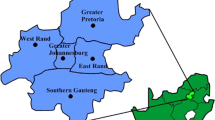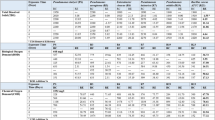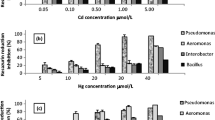Abstract
Carwash effluents contain potentially toxic chemical and microbiological pollutants which may pose public health and ecotoxicological threats if directly discharged into surface waters. This work was aimed at determining the microbiological, physicochemical, and toxicological parameters of carwash effluents. Toxicity assays were determined using whole effluent toxicity (WET) using Danio rerio and Daphnia pulex. For microbiological analysis, sample aliquots were spread plated onto R2A Agar for the isolation of heterotrophic bacteria followed by DNA extraction from axenic cultures for sequencing analysis. The pH of effluent samples lay in the alkaline range, and ranged from pH 7 to pH 10. Sample salinity ranged from 0.2 to 0.3 g/Kg. Electrical conductivity values ranged from 274 to 554 μS/cm. Concentrations of Co, Pb, and Ni were < 1 mg/L in all samples while the concentrations of Cu ranged from 0.94 to 3.8 mg/L and Zn from 1.15 to 3 mg/L. Oil and grease concentrations ranged from 5 to 24 mg/L. The concentrations of TPH-GRO were low at < 1 mg/L in all samples. All the carwash effluents were categorised as acutely toxic, with ≥ 75% mortality recorded for both test organisms within the first 24 h of exposure to the test solutions. Heterotrophic bacteria counts ranged from 2800 to 4600 CFU/100 ml. Sequencing analysis revealed that 57% of the isolates were closely related to Aeromonas species, with 43% closely related to Pseudomonas species. We conclude that carwash effluents are veritable sources of microbiological contaminants and potentially toxic chemical pollutants of public health and ecotoxicological concern.



Similar content being viewed by others
References
Azua-Bustos, A., & González-Silva, C. (2014). Biotechnological applications derived from microorganisms of the Atacama Desert. Biomedical Research International, 2014, 1–7.
Barbazuk, W. B., Korf, I., Kadavi, C., Heyen, J., Tate, S., Wun, E., Bedell, J. A., McPherson, J. D., & Johnson, S. L. (2000). The syntenic relationship of the zebrafish and human genomes. Genome Research, 10(9), 1351–1358.
Bhattacharyya, S., Klerks, P. L., & Nyman, J. A. (2003). Toxicity to freshwater organisms from oils and oil spill chemical treatments in laboratory microcosms. Environmental Pollution, 122, 205–215.
Chaix, G., Roger, F., Berthe, T., Lamy, B., Jumas-Bilak, E., Lafite, R., Forget-Leray, J., & Petit, F. (2017). Distinct Aeromonas populations in water column and associated with copepods from estuarine environment (Seine, France). Frontiers in Microbiology, 8(1259), 1–13. https://doi.org/10.3389/fmicb.2017.01259.
Chandra, R., Bharagava, R. N., Kapley, A., & Purohit, H. J. (2011). Bacterial diversity, organic pollutants and their metabolites in two aeration lagoons of common effluent treatment plant (CETP) during the degradation and detoxification of tannery wastewater. Bioresource Technology. Elsevier Ltd, 102(3), 2333–2341. https://doi.org/10.1016/j.biortech.2010.10.087.
Clarke, R. (1974). A summary of toxicity information for major effluent components from inorganic chemical industries: Teehnieal Report Series No: CEN/T-74-9. Winnipeg.
Das, N., & Chandran, P. (2011). Microbial degradation of petroleum hydrocarbon contaminants: an overview. Biotechnology Research International, 2011, 1–13. https://doi.org/10.4061/2011/941810.
de Souza Anselmo, C., Sardela, V. F., de Sousa, V. P., & Pereira, H. M. G. (2018). Zebrafish (Danio rerio): a valuable tool for predicting the metabolism of xenobiotics in humans? Comparative Biochemistry and Physiology Part - C: Toxicology and Pharmacology., 212, 34–46. https://doi.org/10.1016/j.cbpc.2018.06.005.
eNATIS (National traffic information system). (2016). Retrieved, May, 20, 2016 from www.enatis.com/index.php/statistics/90-live-driver-licences-per-population. Accessed 15 Jul 2016.
Enontiemonria, E. V., Kofi, H., Cybil, O., & Gbenga, T. (2012). The effects of Pseudomonas aeruginosa and Aspergillus niger on the bioremediation of raw and treated crude oil polluted water. International Journal of Science and Technology, 2(6), 345–352.
Gellatly, S. L., & Hancock, R. E. W. (2013). Pseudomonas aeruginosa: New insights into pathogenesis and host defenses. Pathogens and Disease., 67(3), 159–173. https://doi.org/10.1111/2049-632X.12033.
Goldsmith, J. R., & Jobin, C. (2012). Think small: Zebrafish as a model system of human pathology. Journal of Biomedicine and Biotechnology, 2012, 1–12. https://doi.org/10.1155/2012/817341.
Hannes, M. H., & Rousseau. (2012). Early Johannesburg, its buildings and people. ISBN 0-7981-1456-8.
Holloway. (2011). Australian Car Wash Association. Retrieved December, 15, 2018 from wheretowashmycar.com.au. Accessed 15 Dec 2018.
Hussein, I., Abdel, S., & Mona, S. M. (2015). A review on polycyclic aromatic hydrocarbon source, environmental impact, effect on human health and remediation. Egyptian Journal of Petroleum, 25, 107–123.
Ihejirika, C., Njoku-Tony, R. F., Nwachukwu, J. I., Enwereuzoh, U. O., Ashiegbu, D. C., Uche, C. C., & Ojiaku, A. A. (2014). Impact of climate change on the influx of hydrocarbon and heavy metals into a fresh water system. British Journal of Applied Science & Technology, 4(21), 3012–3018.
Kienle, C., Kase, R., & Werner, I. (2011). Evaluation of bioassays and wastewater quality. In In vitro and in vivo bioassays for the performance review in the Project “Strategy MicroPoll”. Duebendorf: Swiss Centre for Applied Ecotoxicology, Eawag-EPFL.
Kiran, A. S., Arthanareeswaran, G., Thuyavan, L. Y., & Ismail, A. F. (2015). Influence of bentonite in polymer membranes for effective treatment of car wash effluent to protect the ecosystem. Journal of Economic and Environmental Safety, 15, 141–144.
Kumar, S., Stecher, G., & Tamura, K. (2016). MEGA7: molecular evolutionary genetics analysis version 7.0 for bigger datasets. Molecular Biology and Evolution, 33, 1870–1874.
Kussovski, V., Mantareva, V., Angelov, I., Orozova, P., Wöhrle, D., Schnurpfeil, G., Borisova, E., & Avramov, L. (2009). Photodynamic inactivation of Aeromonas hydrophila by cationic phthalocyanines with different hydrophobicity. Federation of European Microbiological Societies, 294, 133–140. https://doi.org/10.1111/j.1574-6968.2009.01555.x.
Lane, D.J. (1991). 16S/23S rRNA sequencing. Nucleic Acid Techniques in Bacterial Systematics (Stackebrandt E & GoodfellowM, eds), pp 115–175. J Wiley & Sons, Chichester.
Lu, X. M., & Lu, P. Z. (2014). Characterization of bacterial communities in sediments receiving various wastewater effluents with high-throughput sequencing analysis. Microbial Ecology, 67(3), 612–623. https://doi.org/10.1007/s00248-014-0370-0.
Martino, M. E., Fasolato, L., Montemurro, F., Novelli, E., & Cardazzo, B. (2014). Aeromonas spp.: ubiquitous or specialized bugs? Environmental Microbiology., 16(4), 1005–1018. https://doi.org/10.1111/1462-2920.12215.
Mike, R. (2003). Hydrogen sulphide control using Do sensors. Retrieved November, 10, 2018 from www.hach.com. Accessed 10 Nov 2018.
Moores, J., Pattinson, P., & Hyde, C. (2010). Enhancing the control of contaminants from New Zealand’s roads: results of a road runoff sampling programme. New Zealand Transport Agency research report (pp. 1–161) 395. Retrieved from http://www.nzta.govt.nz/resources/research/reports/395/docs/395.pdf June 2018. Accessed 8 Jun 2018.
O’Sullivan, A., Smalley, D. & Good, J. (2011). Quantifying the impact of car washing on water quality and assessing simple treatment strategies. Christchurch, New Zealand.
Ogbulie, T. E., Ogbulie, J. N., & Umezuruike, I. (2008). Biodegradation of detergents by aquatic bacterial flora from Otomiri River, Nigeria. African Journal of Biotechnology, 7, 824–830.
Ojewumi, M. E., Anenih, E. V., Taiwo, O. S., Adekeye, B. T., Awolu, O. O., & Ojewumi, E. O. (2018). A bioremediation study of raw and treated crude petroleum oil polluted soil with Aspergillus niger and Pseudomonas aeruginosa. Journal of Ecological Engineering, 19(2), 226–235.
Oluwaseun, O., Olutoyin, B., & Jackson, V. (2016). Bioremediation of polycyclic aromatic hydrocarbon (PAH ) compounds : (acenaphthene and fluorene) in water using indigenous bacterial species isolated from the Diep and Plankenburg rivers, Western Cape, South Africa. Brazilian Journal of Microbiology, 48(2), 314–325. https://doi.org/10.1016/j.bjm.2016.07.027.
Picaõ, R. C., Poirel, L., Demarta, A., Silva, C. S. F., Corvaglia, A. R., Petrini, O., & Nordmann, P. (2008). Plasmid-mediated quinolone resistance in Aeromonas allosaccharophila recovered from a Swiss lake. Journal of Antimicrobial Chemotherapy, 62, 948–950.
Rampelotto, P. H. (2013). Extremophiles and extreme environments. Life, 3, 482–485.
Rice, S. D., Moles, D. M., Karinen, J. F., Korn, S., Carls, M. G., Brodersen, C. C., Gharrett, J. A., & Babcock, M. M. (1984). Effects of petroleum hydrocarbons on Alaskan aquatic organisms: a comprehensive review of all oil-effects research on Alaskan fish and invertebrates conducted by the Auke Bay Laboratory, 1970-81. Auke Bay, Alaska 99821.
Ritchie, G. D., Still, K. R., Rossi, J., Bekkedal, M. Y. V., Bobb, A. J., & Arfsten, D. P. (2003). Biological and health effects of exposure to kerosene based jet fuels and performances additives. Journal of Toxicology and Environmental health Critical Reviews, 6, 357–451.
Rotini, A., Manfra, L., Spanu, F., Pisapia, M., Cicero, A. M., & Migliore, L. (2017). Ecotoxicological method with marine bacteria Vibrio anguillarum to evaluate the acute toxicity of environmental contaminants. Journal of Visualized Experiments, (123), e55211. https://doi.org/10.3791/55211.
Sablayrolles, C., Vialle, C., Vignoles, C., & Montrejaud-Vignoles, M. (2010). Impact of car wash discharge on stormwater quality (Toulouse, France). Water Science and Technology, 62(12), 2737–2746. https://doi.org/10.2166/wst.2010.929.
Saitou, N., & Nei, M. (1987). The neighbor-joining method: a new method for reconstructing phylogenetic trees. Molecular Biology and Evolution, 4, 406–425.
SeaWeb. (2008). Chemicals in our waters are affecting humans and aquatic life in unanticipated ways. ScienceDaily. Obtained from www.sciencedaily.com/releases/2008/02/080216095740.htm. Accessed 21 Dec 2018.
Shah, A. (2017). ‘Heavy metal impact on aquatic life and human health – an overview’, in 37th Annual Conference of the International Association for Impact Assessment. Montreal, Canada, (pp. 1–7).
Shahbazi, R., Kasra-Kermanshahi, R., Gharavi, S., Moosavi-Nejad, Z., & Borzooee, F. (2013). Screening of SDS-degrading bacteria from car wash wastewater and study of the alkylsulfatase enzyme activity. Iranian Journal of Microbiology, 5, 153–158.
Sherry, J., Scott, B. F., Nagy, E., & Dutka, B. J. (1994). Investigation of the sub-lethal effects of some petroleum refinery effluents. Journal of Aquatic Ecosystem Health, 3, 129–137.
Sibanda, T., Selvarajan, R., & Tekere, M. (2015). Urban effluent discharges as causes of public and environmental health concerns in South Africa’s aquatic milieu. Environmental Science & Pollution Research, 22, 18301–18317. https://doi.org/10.1007/s11356-015-5416-4.
SoC. (2007). Aquatic toxicity testing (Fields of Testing/Accreditation 113 and 119). Richmond: Department of Public Health.
Stamenov, D., Duric, S., & Jafari, T. I. H. (2015). Bioremediation potential of five strains of Pseudomonas sp. Matica Srpska Journal of National Science Novi Sad, 128, 41–46. https://doi.org/10.2298/ZMSPN1528041S.
StatSA. (2015). Mid-year population estimates. Retrieved, July, 2015 from www.statssa.gov.za. Accessed 15 Jul 2016.
Su, C., Lu, Y., Johnson, A. C., Shi, Y., Zhang, M., Zhang, Y., Juergens, M. D., & Jin, X. (2017). Which metal represents the greatest risk to freshwater ecosystem in Bohai Region of China? Ecosystem Health and Sustainability, 3(2), e01260. https://doi.org/10.1002/ehs2.1260.
Tamura, K., Nei, M., & Kumar, S. (2004). Prospects for inferring very large phylogenies by using the neighbor-joining method. Proceedings of the National Academy of Sciences of the United States of America, 101, 11030–11035.
Tekere, M., Sibanda, T. & Maphangwa, K.W. (2016). An assessment of the physicochemical properties and toxicity potential of carwash effluents from professional carwash outlets in Gauteng Province, South Africa. Environmental Science and Pollution Research. https://doi.org/10.1007/s11356-016-6370-5.
Tonkes, M., & Baltus, C.A.M. (1997). Praktijk onderzock aan komplexe effleneten met de total effluent milieu bezwaarlikheid (TEM) motodiek. Rizarapportnummer 97, 033 Riza. Netherlands.
UNWUP. (2016). The world’s cities in 2016. Retrieved June, 15, 2016 from www.unpopulation.org.
USEPA. (2000). Office of environmental information. 2810A. Washington, D.C. 20460. Accessed 8 Nov 2018.
Vinodhini, R., & Narayanan, M. (2009). The impact of toxic heavy metals on the hematological parameters in common Carp (Cyprinus carpiol). Iran Journal of Environmental Health Science and Engineering, 6(1), 23–28.
Vinothini, C., Sudhakar, S., & Ravikumar, R. (2015). Biodegradation of petroleum and crude oil by Pseudomonas putida and Bacillus cereus. International Journal of Current Microbiology and Applied Sciences, 4(1), 318–329.
Wang, Z. H., Yang, J. Q., Zhang, D. J., Zhou, J., Zhang, C. D., Su, X. R., & Li, T. W. (2014). Composition and structure of microbial communities associated with different domestic sewage outfalls. Genetics and Molecular Research, 13(3), 7542–7552. https://doi.org/10.4238/2014.
Xie, Y., Fan, J., Zhu, W., Amombo, E., Lou, Y., Chen, L., & Fu, J. (2016). Effect of heavy metals pollution on soil microbial diversity and bermudagrass genetic variation. Frontiers in Plant Science, 7, 755. https://doi.org/10.3389/fpls.2016.00755.
Yasin, S., Iqbal, T., Arshard, Z., Rustan, M., & Zafar, M. (2012). Environmental pollution from automobile vehicle service stations. Journal of Quality and Technology Management, 8, 61–70.
Zarei, I., Pourkhabbaz, A., Alipour, H., & Khazaei, S. H. (2013). Acute toxicity and the effects of copper sulphate (CuSO4.5H2O) on the behavior of the black fish (Capoeta fusca). Iranian Journal of Toxicology, 6(19), 771–778.
Funding
This research was financially supported by the Division of Student Funding (Dsf) of the University of South Africa (UNISA) and the UNISA Women Research Award to Prof M. Tekere.
Author information
Authors and Affiliations
Corresponding author
Additional information
Publisher’s note
Springer Nature remains neutral with regard to jurisdictional claims in published maps and institutional affiliations.
Rights and permissions
About this article
Cite this article
Nguegang, B., Sibanda, T. & Tekere, M. Cultivable bacterial diversity, physicochemical profiles, and toxicity determination of car wash effluents. Environ Monit Assess 191, 478 (2019). https://doi.org/10.1007/s10661-019-7600-3
Received:
Accepted:
Published:
DOI: https://doi.org/10.1007/s10661-019-7600-3




